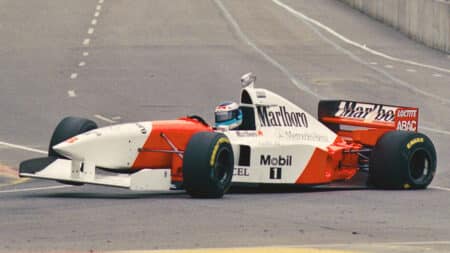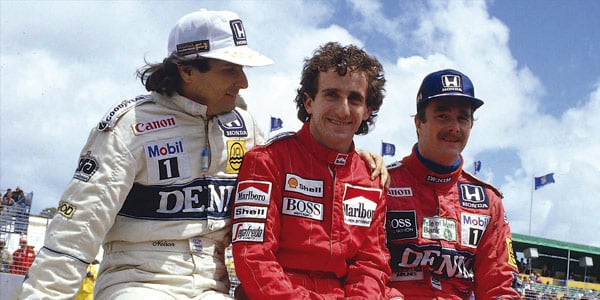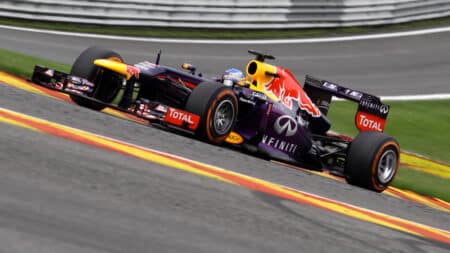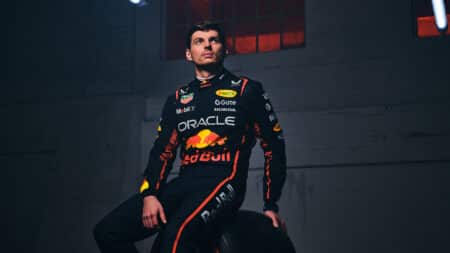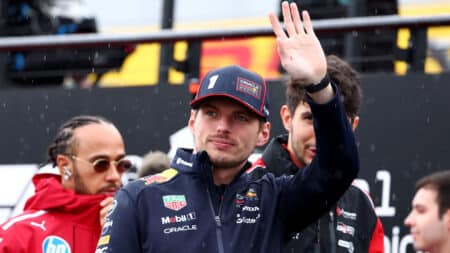“It’s a long way down here, isn’t it?” said Alain Prost. “I must say I’m glad to have a chance of winning the title, even if it’s a small one…” This was Adelaide in October 1986, and Prost had that chance because of a brilliant drive in Mexico two weeks earlier.
Through the year his McLaren-TAG had been outpowered by the Williams-Hondas of Nigel Mansell and Nelson Piquet, and while there had been demonstrations of his driving superiority – at Monaco he simply left everyone behind – he remained in title contention because he unfailingly got the maximum from his car, because his racecraft was without equal.
“In Mexico Alain drove a truly incredible race,” said Ron Dennis. “We’ve always had a lot less power than the Williams-Hondas, but this time – to make it worse – he was on five cylinders for half the race and didn’t dare to make a second tyre stop, for fear of losing the engine. On a very abrasive track he had to make two sets last the whole race: Mansell needed three, and Piquet four. Alain finished ahead of both of them…”
Prost’s other surpassing skill, in that era, was juggling speed and fuel. In 1986 there was a restriction of 195 litres for a race, and it took a lot of will to keep your boost down in the early laps, while less disciplined rivals charged away.
Still his title hopes looked flimsy. A driver’s score was based on his best 11 results (from 16 races), and both Prost and Mansell had already needed to drop points, having scored in more than 11 events. Nigel had 70 points, Alain 64, and Nelson Piquet 63 – but if either Mansell or Prost should add points in Adelaide, they would shed their lowest score once more, whereas Piquet would not. That said, Nigel was the heavy favourite: whatever else happened, third place would be enough.
Prost wasn’t fazed. “Actually, I like this situation. In a way, it’s like driving for your life – you have to win. For Nigel it’s more difficult, because he has choices he can make…”
It was not often back then that the World Championship went down to the wire, and rarer still for more than two drivers to be in contention. If the weather – cool and grey – decided not to honour the occasion, it didn’t detract from an extraordinary atmosphere through the qualifying days. Given his power deficit, Prost knew pole was out of the question, and concentrated, as always, on a perfect set-up for race day.
As anticipated, the fight for pole was between the Williams-Hondas, with Ayrton Senna’s Lotus-Renault close by. Ultimately, Mansell took it, three-tenths faster than Piquet, with Senna third, Prost fourth. Alain grinned when he saw the times: “Ha! Three guys ahead of me – and they all hate each other!”
On Sunday the weather was again cheerless, but there was no forecast of rain. Senna was fastest in the warm-up, but Prost was next up, ahead of Mansell and Piquet.
The first lap was as intense as anyone could remember, with Mansell leading away, then – unwilling to get involved in any early wheel-banging – moving over to let Senna and Piquet by. At the end of the Dequetteville Straight, Nelson outbraked Ayrton, and thus the race already had its third leader in the space of two miles.
The man really on the move, though, was Keke Rosberg, who had started seventh, but was up to third by the end of the opening lap. Next time around Keke passed Senna, moving up to menace Piquet, and by lap seven he was into the lead, going away. “I’ll never understand it,” he sighed, “but the car was perfect for me, without its usual understeer. I hadn’t liked it in practice, but on race day it transformed itself. I was enjoying myself so much I began to wish I hadn’t decided to retire.”
At the same time Prost began to move. Typically, he had begun quietly, sitting in fifth place, waiting for the initial dust to settle. Now he moved past Senna, and on lap 11 went ahead of Mansell.
“Often,” said Patrick Head, “we’d be way ahead of him at first, and think, ‘Where’s Alain?’ He’d qualify third or fourth, make a slow start, and you’d think, ‘Great, that’s him out of the way’. Then you’d see that he was fifth, fourth, third, and you’d think, ‘Ooooh, shit!’ That inexorable quality was very much him. It was like that in Adelaide.”
By lap 23, with Rosberg well ahead, Prost passed Piquet for second place, after which Nelson immediately spun, falling to fourth. For McLaren, now running 1-2, everything was looking good, for if it came to it, Keke would undoubtedly let Alain through before the flag.
Mansell, though, continued to run third, where he needed to be. If he could hold station until the end he would be World Champion, and on lap 32 his prospects vaulted, for Prost slowed, his right front tyre punctured.
Tyre changes were then by no means an automatic feature of Grands Prix, and Prost seemed to be out of the championship fight. After a 17-second stop – it took time to get a jack under the McLaren in its lowered state – he rejoined, now a long way back. Immediately
a series of record laps began.
“People probably won’t believe me,” Alain told me later, “but I was always going to change tyres – even the lap for the stop was agreed. To be honest, before the race I almost changed my mind – if the others weren’t stopping, maybe I should do the same – but I came back to logic. I’d worked a lot with the car and tyres during practice: I knew it would be marginal to go all the way without changing – and I also knew my car was easier on tyres than the Williams.
“What lost me the time,” he said, “was the slow lap back to the pits. After that, all I could do was push as hard as possible. There was nothing to lose – even second place was no use to me.”
In the pits Goodyear engineers examined the tyres discarded by Prost, and concluded that the wear rate was less than they had expected. All being well, they felt, no one would need to stop.
Head grimaces at the memory. “We had a big horsepower advantage, and therefore were able to run more downforce than anyone else. Honda couldn’t tell us how much power we had, because they didn’t know. Their dyno only registered up to 1000 horsepower – which they were reaching at 9300rpm. We were revving to 13,500 or so…
“I’ve no doubt it was because we were able to run so much wing that we encountered tyre problems, and I was annoyed afterwards when one of the Goodyear people told the press that Williams had been advised to make a stop. That was absolutely not the case.”

At this stage, though, Williams had no cause for worry. For close to 30 laps there was virtual stalemate, Rosberg still leading from Piquet, a serene Mansell, and a charging Prost.
Then, on lap 63, with 19 to the flag, the full drama of the day began to unravel: Rosberg heard unwelcome noises from the back of his McLaren, and swiftly parked, believing the engine had run its bearings. In fact, when he got out, Keke realised that what he had heard was a delaminating tyre flapping against the bodywork. His right rear Goodyear was in tatters. “I was lucky,” he said, “because one of my brake discs was about to come apart, and I wouldn’t have wanted to find that out at the end of Dequetteville…” A sad end to his last GP, but he could savour a stirring finale.
As Rosberg retired, so Prost, running at the limit, passed Mansell for second place – but still Nigel had a lock on the four points he needed.
“At that stage,” said Head, “he could have stopped for tyres and still won the title, because there was no one close behind him.”
Only a lap later the outcome of the World Championship was settled. Mansell, flat out down Dequetteville, and in the process of lapping Philippe Alliot’s Ligier, suddenly had his left rear tyre disintegrate. From 190mph, he fought the bucking Williams to a halt, parking in the escape road, then stumbling back to the pits. “To be honest, I’m glad simply to be in one piece,” he mumbled. It was beyond cruel.
“At no time,” said Head, “did we think we were taking any sort of gamble. I don’t blame Goodyear for the fact that it happened, but they gave us no reason to consider we needed to change. You’ve got to remember that it didn’t explode because it was worn out – the bits of tyre that were recovered indicated that the carcass had failed, by fatigue…”
Now it was simply Piquet against Prost, each needing the nine points for victory to take them past Mansell’s total. It was winner take all, and Prost was only two seconds behind.
As it was, the duel never materialised. “After Nigel’s tyre had failed, we were between a rock and a hard place with Nelson,” said Head. “If we’d left him out, and he’d made it, we’d have looked like heroes, but if he’d had an accident and hurt himself, we’d have looked idiots. There was no choice but to call him in…”
Piquet stopped on lap 65, and was still in second place when he went back out. “It was the right decision, to change tyres,” he said. “I knew I might be losing the championship, but I didn’t care. I was alive.”

Now it was Nelson’s turn to apply the pressure, but he made little impression on Prost until the last four laps, when Alain dramatically cut his pace: “From the halfway point, my fuel read-out had been telling me I was five litres the wrong side – that I wouldn’t make the finish unless I backed off. But of course I couldn’t do that, because I was so far behind, after my puncture, so I just had to hope that, for once, the computer was wrong…”
It was. Although Piquet set another record on the final lap, Prost crossed the line four seconds to the good, both arms raised in salute.
For once a championship decider had not only lived up to expectations, but exceeded them. “These days,” said Jackie Stewart, “you don’t often see a guy win a GP in a slower car – but this guy’s won the championship in one! People will say Nigel lost it because of his tyre failure, but you could also say he lost it in Mexico, where he started in third gear, dropped to the back, then began blistering tyres and finished fifth. He could have clinched the title that day, but instead he dropped four points to Prost – and he lost the title by two. To my mind, there’s no one near Alain.”
In my experience, this remains the most memorably dramatic F1 race of all time.
